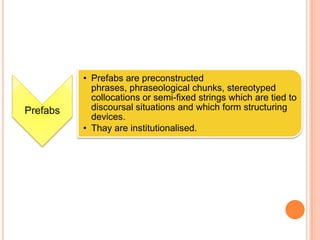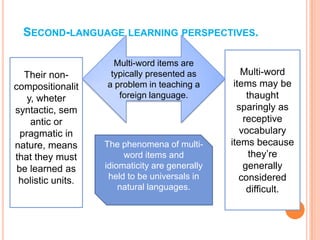Vocabulary connections
- 1. VOCABULARY CONNECTIONS: MULTI- WORD ITEMS IN ENGLISH By: Dannae Del Campo Méndez
- 2. MULTI-WORD ITEMS: TERMS AND CATEGORIES multi-word item : is a vocabulary item which consist of a sequence of two or more words. Multi word items are the result of lexical (and semantic) processes of fossilisation and word-formation. Rather than the results of the operation of grammatical rules
- 3. THERE ARE 3 IMPORTANT CRITERIA WHICH HELP DISTINGUISH HOLISTIC MULTI-WORD ITEMS FROM OTHER KINDS OF STRINGS. • Is the degree to which a multi- Institutionalisation word item is conventionalised in the language. • Is the degree to which a multi- Fixedness word is frozen as a sequence of words. • Is the degree to which a multi- Non- word item cannot be interpreted compositionality on a word-by-word basis.
- 4. TYPES OF MULTI-WORD ITEM : • Coumpounds as Nouns: Prime Minister, crystal ball, etc… • Compound Verbs: are typically hyphenated (freeze- dry) . Others are verbal uses of compound nouns; (short-circuit, rubber-stamp). • Compound Adjectives: are often hyphenated. It Compounds could be formed by an adejective and a participle (long-haiired). Or a modifier and superordinate adjective(navy blue, powder blue). • Are combinations of verbs and adverbial or prepositional particles (up , out , off , Phrasal in , on and down) Verbs • The verbs are typically monosyllabic.
- 5. • They have holistic meanings which cannot be retrieved from the individual meanings of component words. • They are typically metaphorical in historical or etymological terms. Idioms • Idioms are rate highly in terms of non- compositionality. • They include items such as: of course, at least, in fact and by far. As well as greetings such as: good morning, how do yo do, etc… Fixed • They are very high frequency items (strongly Phrases institutionalised) , and many are strongly fixed.
- 6. • Prefabs are preconstructed phrases, phraseological chunks, stereotyped collocations or semi-fixed strings which are tied to Prefabs discoursal situations and which form structuring devices. • Thay are institutionalised.
- 7. MODELS OF MULTI-WORD ITEMS Semantics- Syntax- based based Models models -They are the most traditional. -They take grammatical well- formedness as their starting-point. - They attempt to differentiate - Multi-word items, and in particular between categories of multi-word idioms and fixed phrases, are often items. non-compositional.
- 8. MULTI-WORD ITEMS AND CORPUS EVIDENCE. Corpus linguistics over recent years has made it possible to examine lexis in a more scientific and objective way. First Generation corpora of up to 1 million words showed limited evidence for many multi-word items: they proved simply too rare and too genre-specific to show up. Second Generation corpora of aroun 20 million words were able to improve on this sitation.
- 9. VARIABILITY IN MULTI-WORD ITEMS Lexical Phrases and Prefabs are often fluid, of course, but Idioms also show remarkable degrees of variation. Varying Lexical Transformation: British/ American Component: Variations : Break the ice/ ice- Burn your boats breaker/ ice- Hold the fort(British) /bridges Hold down the breaking Throw in the fort(American) towel/sponge Unstable Verbs: Truncation: Show/declare/rev Silver lining/ every eal your true cloud has a silver colours lining
- 10. MULTI-WORD ITEMS IN TEXT AND DISCOURSE Let’s explore multi-word items, text and genre by looking three types of extracts. A handbook on The opening of a A short extract painting: report on a soccer from a screenplay: match: • It is a technical • There is piece of writing. • It is highly emotive compounds, infor and evaluative text. mal phrasal verbs, • Includes a lot of compound words. • Use of • This attempts to adjectives, Idioms, c replicate natural • A common multi- ompound adjectives word item is “in speech patterns. (Multi.word), Phrasal contrast” verbs,etc…
- 11. SECOND-LANGUAGE LEARNING PERSPECTIVES. Multi-word items are Their non- typically presented as Multi-word compositionalit a problem in teaching a items may be y, wheter foreign language. thaught syntactic, sem sparingly as antic or receptive pragmatic in vocabulary nature, means The phenomena of multi- items because that they must word items and they’re be learned as idiomaticity are generally generally holistic units. held to be universals in considered natural languages. difficult.










